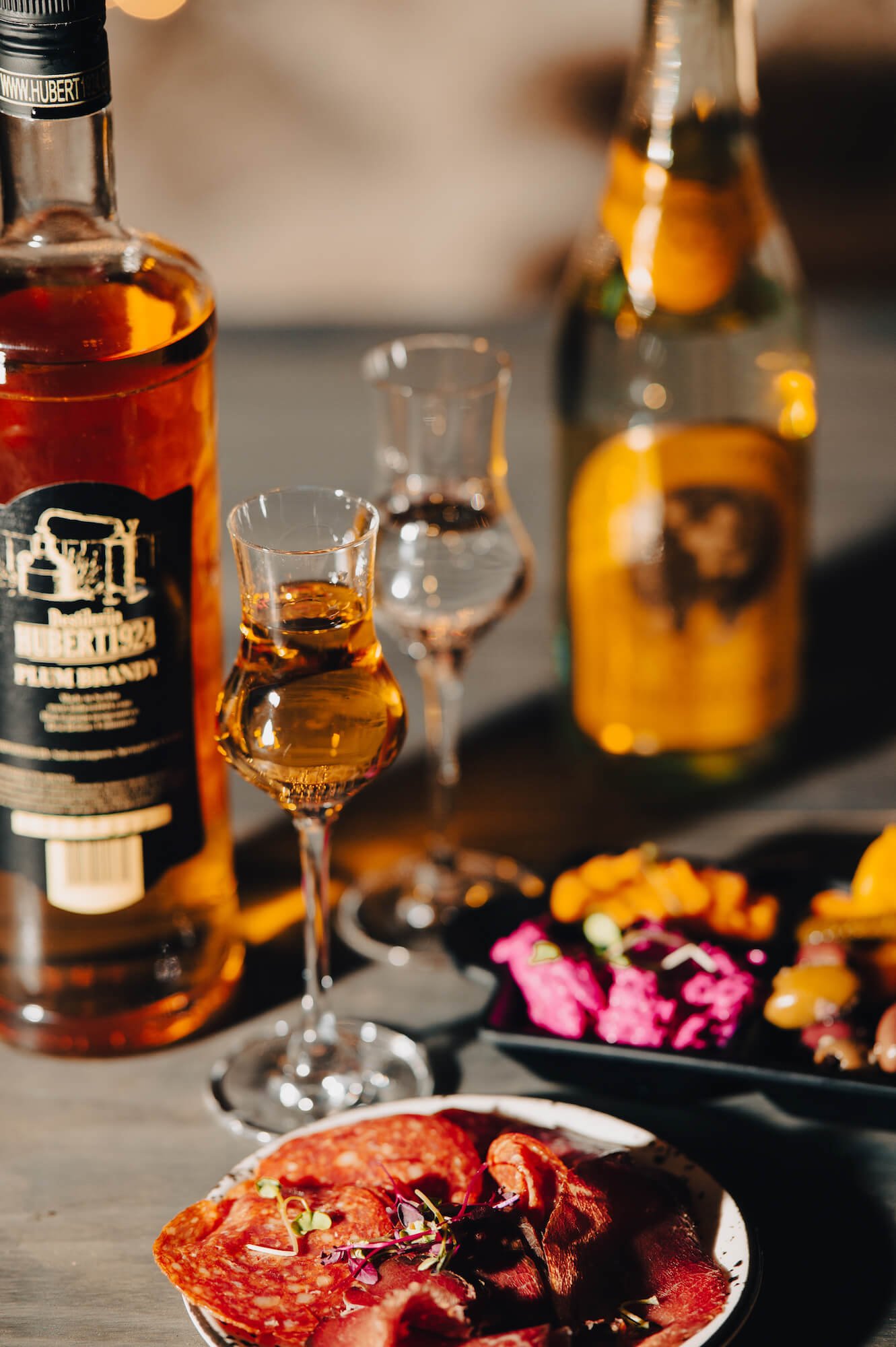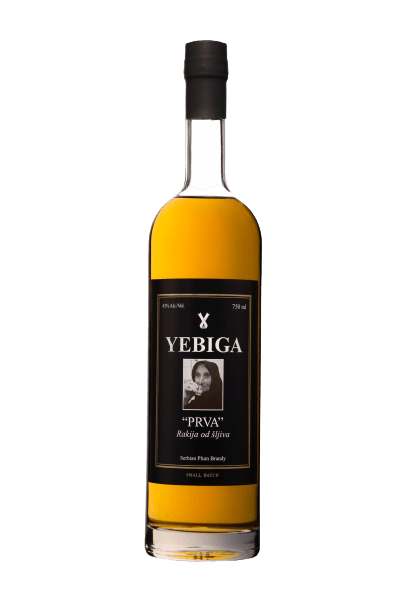Could the Balkan Spirit Rakia Be the Next Big Thing in Brandy?
The historical fruit-based Balkan spirit Rakia is unique, approachable and versatile—and popping up in a shaker or shelf near you.
Liquor stores and drinks menus are stocked with an ever-increasing selection of new brands of tequila, mezcal and bourbon. But an under-the-radar beverage in another category may be slowly gaining traction among spirits fans.
What is Rakia?
Rakia photo courtesy of Ambar
Rakia is a category of fruit brandy popular in the Balkans. (The spelling varies depending on the country of production. For example, it’s called rakija in Croatia, Bulgaria and Macedonia and rakiya in Bulgarian.) It’s most commonly distilled from plums, apricots or grapes, and to a lesser extent from cherries, figs, quince, apples, pears, peaches and blackberries, and may be blended with sour cherries, walnuts, honey and herbs before bottling—usually at 80 proof. Fruity but not always sweet, and juicy, mouthwatering and enticing, rakia can be sipped straight, poured over ice and mixed into cocktails. No wonder it’s garnering an increasing number of fans (and champions) in the U.S.
Promoting Rakia
Photo courtesy of Ambar
“In the past we had to introduce this spirit a lot, [but] now it's very common for guests just to order it without even looking at the menu,” says Uros Jojic, general manager of Ambar, the Balkan small plates concept with locations in Washington, D.C., Arlington, Virginia and Belgrade, Serbia. “We intentionally were offering complimentary rakia to our guests as part of our hospitality, but also to expose it to the U.S. market and offer our diners something they hadn’t had the chance to try before.”
To introduce the brandies to more palates, last fall Ambar’s D.C. location held a Rakia Tasting Challenge. Over a three-month period, guests had the opportunity to win a tiered level of prizes by sampling some or all of the flavors listed on a tasting card. Those up to the challenge of imbibing 1.45 oz. of all 33 varieties received a special 750 ml bottle, housed in a private locker to enjoy while dining at Ambar.
Rakia options at Ambar include Zaric Plum (called Slivovitz in the U.S.) which is produced with high-altitude grown plums in Kosjeríć, Serbia. Also popular are Zaric Koketa Cherry, flavored with cherry distillate and squeezed cherry juice; and Hubert Apricot, made with hand-picked apricots and double-distilled in copper pots.
Culture of Rakia
Photo courtesy Ambar
For those unfamiliar with the category, Jojic and staff first explain its cultural significance to those in the Balkan region, as well as how it’s produced. Rakia is the national drink of Serbia, is considered the most popular spirit in Croatia, and is associated with parties, festivities and celebrations throughout the Balkans. In Albania, it’s presented to welcome guests into your home and employed as part of the religious rituals of the Orthodox Christian faith. “Once we get to the part where we try to compare this spirit to something else, we realize there is nothing similar on the market,” admits Jojic.
How to Enjoy Rakia
Rakia is generally served before a meal as an aperitif or sipped while enjoying mezze. (Ambar offers a wildly-popular bottomless Balkan small plates option, perfect for tasting your way through the liquid offerings.) Alongside desserts like baklava or chocolate mousse cake with nut crumble, guests favor honey or cherry rakia instead of a sweet wine—so much so that Ambar completely removed dessert wines from the menu.
Its intense flavors also make rakia a versatile ingredient in cocktails with limitless combinations, especially when bartenders are trying to enhance the fruity flavors. Plum rakia can be used in place of or with whiskey in classic drinks like the Old Fashioned and Manhattan, their riff on a Collins uses apricot rakia with elderflower liqueur, orange and lemon juices and simple syrup, and Quince Up shakes quince rakia with apple and lemon juices, simple syrup and rhubarb bitters.
Yebiga Rakia
Still, unless you happen to live in an area with a Balkan restaurant or a liquor store stocked with an eclectic selection of global offeings, rakia has admittedly often been a bit hard to come by. That is, until a few years ago, when Yebiga Rakia, a premium Serbia fruit brandy, was released.
Photo courtesy Yebiga Rakia
“I became very attached to rakija through my decades of traveling the Balkans, and both flabbergasted and frustrated that there was so little awareness of it here,” says Yebiga Rakia founder William Gould. “So my goal was to create a classic proper, premium version made by hand with a strict adherence to the process and only pure ingredients—in this case, only plums and water.” While he was initially stirred to create a rakia solely for himself and expats missing the good stuff from back home, he came to believe it’s a drink that deserves more attention. “I am truly excited to share this with people,” he says. “I want them to know what they've been missing.”
Yebiga is available in two expressions. Prva (SRP $38.99) follows the Serbian recipe of using one variety of fresh, ripe, local plum, hand-picked, distilled and barrel-aged for 18 months. Time spent in oak lends spice and vanilla tones along with piney, Christmas notes, while its warmth, viscosity and lengthy finish pair well with coffee, charcuterie, cheeses vanilla or chocolate ice cream, eggnog or cigars. It can also easily stand in for whiskey in boozy and stirred cocktails.
Photo courtesy Yebiga Rakia
Bela (SRP $29.99) is a lighter, fresher, younger expression made with a mixture of two plums distilled and aged in stainless steel, which brings out more delicate floral notes. Since it’s unoaked, it’s sometimes described as a really smooth plum grappa and pairs with salads, cakes, pastries and sorbets. It’s also a perfect substitute for vodka in a Martini or Bloody Mary, or in a selection of slightly Balkan-ized drinks curated by creative director Naren Young, formerly of acclaimed New York craft cocktail bar Dante.
Both Jojic and Gould agree that while rakia is niche right now in the U.S., it’s deserving of more of a closer look (and taste) by spirits aficionados. “My goal here is to introduce this into the American conversation, let's see where we are in the next two to three years,” says Gould. “This might be the best spirit you’ve never had.”
Rakia Cocktails
Photo courtesy Yebiga Rakia
Serbian Breakfast
Recipe courtesy of Yebiga Rakia
1 ½ oz. Rakija PRVA
½ oz. Luxardo Maraschino
¾ oz. lemon juice
1 bar spoon of cherry marmalade
3 brandied cherries, skewered, for garnish
Add the first four ingredients to a cocktail shaker, add ice and shake until well chilled. Strain into a chilled Nick & Nora glass, and garnish with the skewered cherries.
Selo Bordello
Recipe courtesy of Yebiga Rakia
Photo courtesy Yebiga Rakia
1 ½ oz. Rakija Bela
¼ oz. Green Chartreuse
¼ oz. dry Sherry
¾ oz. lime juice
Pinch of Maldon salt
Bar spoon of white wine vinegar
3 basil leaves, torn
1 basil leaf, for garnish
Add all ingredients except garnish to a cocktail shaker, add ice and shake until well-chilled. Fine strain into a chilled Nick and Nora glass and garnish with the reserved basil leaf.







